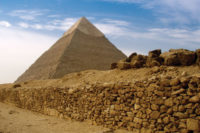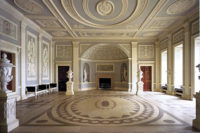Gypsum is a naturally occurring rock, a metallic salt of calcium. It commonly forms as an evaporite from the dissolution of limestone by exposure to sulphuric acid from volcanic activity. Under certain conditions such as low-lying lagoons, continual cycles of dissolution and evaporation will agglomerate a “primary” deposit of gypsum.
Mineral gypsum formed is interspersed among other minerals. Primary deposit gypsums are characterized by a loose crystalline structure and high solubility in water. Over geologic time, gypsum from primary deposits can be dissolved by flowing water carried away in solution, forming a “secondary” deposit of a much purer gypsum. These secondary deposits form as beds of rock known as “massifs” that can be tens of feet thick and run for hundreds of feet. These massifs of gypsum rock are found all over the world and are the main source exploited as raw material for creating gypsum plaster.
Chemistry & Manufacturer
The most common form of naturally occurring gypsum has the chemical formula: calcium sulphate dihydrate or CaSO4·2H2O. This “hydrous” or watery gypsum binds water to calcium sulphate molecules in a dry, crystalline state. As we’ll see, this imbues gypsum plasters with some amazing properties. If water held “frozen” at ambient room temperature doesn’t already sound incredible, the alchemy of burning stone to convert it into a plaster or mortar, to be subsequently reconstituted into stone in a place and shape of our choosing, is downright magical.
Unlike clay, mineral gypsum must be baked in preparation for its use as a plaster. Fortunately, this occurs at a relatively low temperature so it is not an energy intensive process. Gypsum rock can be efficiently baked at temperatures as low as 300 degrees Fahreinheit. At this temperature gypsum quickly loses 75 percent of its water content, off-gassing steam. The resulting material has the chemical formula calcium sulphate hemi-hydrate or CaSO4·½H2O. Commonly known as Plaster of Paris, this is the most prevalent form of gypsum used for plasters.
In the 19th century, it was discovered that gypsum baked under increased atmospheric pressure in a barometric chamber would result in dense plasters, having less water demand. These “gypsum cements” require less water to mix and manifest a distinct crystallization pattern that produces dense, hard sets very useful in casting work. Anhydrous gypsum is another form of gypsum stone that occurs naturally or can be manufactured by continuing to bake the hydrous form over a temperature of 800 degrees Fahrenheit, producing anhydrous calcium sulphate or CaSO4. This anhydrous or “dead burnt” gypsum, sometimes with a small addition of alum, is characterized by a slower set and dense crystallization useful for floor, exterior and other specialty applications such as scagliola, a technique utilizing gypsum plaster to imitate marble, porphyry and other precious stones.
Properties & Specifications
There are several characteristics that are inherent to all gypsum plasters. Notable among them is that gypsum plaster is self-binding. Aggregates may be added as an inexpensive filler or for decorative effect; however, unlike clay or lime, they are not necessary for the plaster to hold together. A closely related quality is that gypsum plasters do not shrink as they set. As gypsum plaster incorporates most of the added water into its crystalline matrix it actually expands slightly as as-is sets. Considered another advantage, Plaster of Paris and the gypsum cements in particular are fast setting materials that permit work to be conducted expeditiously.
Gypsum plasters have excellent adhesion to most any solid, fibrous or lath substrate and provide a permeable, breathable coating. Furthermore, the combination of these unique characteristics of self-binding and rapidity of setting result in gypsum being the perfect binder for molding and ornamental applications. Both Plaster of Paris and gypsum “cements” can be mixed to a light cream consistency, capturing the finest of details.
Historically, gypsum plasters have been used more commonly for interiors, although there are some traditions of exterior use as well. Although all natural plasters are incombustible, gypsum is practically miraculous in its inherent capacity to actively suppress fire. This is due to its hydrous chemistry. Should a fire occur in one room, gypsum will continue to off-gas steam, thus suppressing the temperature on the other side of the wall well below the temperature needed for spontaneous combustion. The steam and suppression of temperature starve the fire of needed oxygen and energy, strongly curtailing the ability of the fire to spread.
Although Plaster of Paris produces a plaster far too porous and soluble for exteriors and gypsum cements are simply not practical to use as a wall plaster, there is a long history of exterior stuccoes in Europe based on anhydrous gypsum. Similar to earthen renders, reasonable precautions need to be taken with overhangs and other flashing details to ensure protection from streaming water as well as establishing water tables to prevent capillary water rise.
The self-binding nature of the gypsum plaster offers a great range of technical and aesthetic freedom. Gypsum stuccoes are very manageable to work as a wall plaster and can be applied up to an inch or more in a single coat while their rapid set permits working in almost any season so long as there is a brief window of good weather. Furthermore, molding profiles can be run in situ, ornamentation can be cast and affixed and a practically unlimited variety of aggregates can be added for simply decorative effect.
In my next column, we’ll begin our series on limes—an entire family of minerals that produce plasters that are closely related chemically to gypsum and that are intimately associated with the rise of civilization itself.














